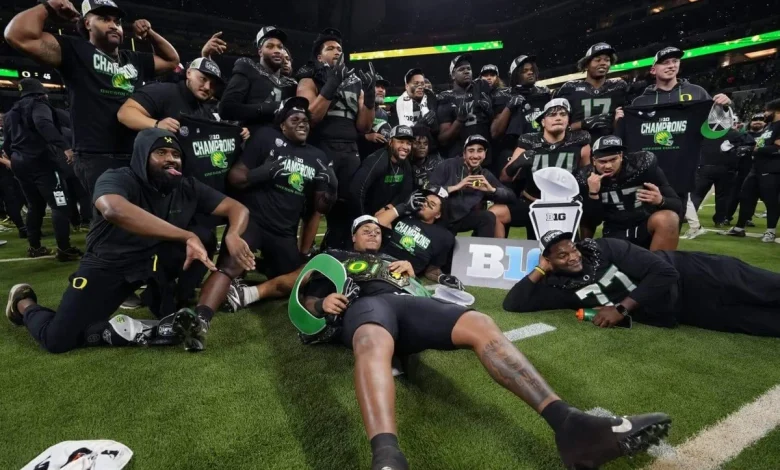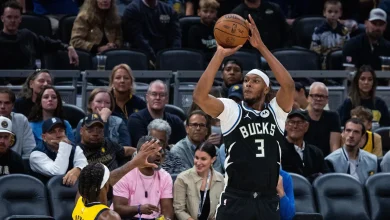Ranking the Big Ten’s 18 head coaching jobs: Which schools are best set up for success? – The Athletic

For the better part of a century, the Big Ten rationalized its lack of championship results in football by touting its academic profile and elevated recruiting standards. But with the expanded College Football Playoff, lucrative media rights deals and above-board player compensation, those excuses no longer are tolerated. Good riddance to tweed-coated conceit.
Now, the league sees itself for what it is: a football factory. After multiple expansions, there is more on-field variance from Big Ten programs than there was in the pre-CFP era. But when it comes to coaching jobs, the tiers of quality haven’t changed much from what they were two decades ago. Ohio State, Michigan and Penn State are a level up on the rest of the original Big Ten. The former Pac-12 teams that arrived in 2024 have added firepower at the top, though a few of the conference’s recent additions have struggled to catch up.
With Penn State seeking a new coach a potential change looming at Michigan State and Wisconsin announcing it will sit out this year’s carousel to bring back Luke Fickell for 2026, it’s the perfect time to rank the Big Ten’s coaching jobs. Here’s how they break down, separated into four tiers.
Top Tier
1. Ohio State
The Big Ten’s flagship football program has everything in place for success: brand, finances, recruiting prowess and annual national title potential. A coach has access to whatever he could want to win at the highest level. There’s a legitimate argument that this is the nation’s top job. But it has also become the nation’s most intense pressure cooker for coaches, surpassing Notre Dame. With an expanded College Football Playoff, an Ohio State coach now can survive a loss to Michigan — as long as he wins the national title. Just ask Ryan Day.
2. Oregon
The power of the Nike Swoosh makes this one of the Big Ten’s best jobs and a top-10 gig nationally. With Nike available for cutting-edge gear and name, image and likeness checks for returning stars and newcomers alike, Oregon can flex in football. It also boasts one of the nation’s loudest and most iconic stadiums. Two different coaches (Chip Kelly and Mark Helfrich) have guided Oregon to national title game appearances the last 15 years, and current coach Dan Lanning led the Ducks to a league title in their first Big Ten season. This program can sustain itself no matter who is in charge.
3. USC
The Trojans are 20 years removed from their dynastic peak under Pete Carroll, but they’ve had several spikes since winning back-to-back national titles in 2003 and 2004. USC owns L.A. when it comes to college football, which entices prospects and creates unique NIL opportunities. USC has always recruited nationally, and now competing in a coast-to-coast conference against comparable brands, it can contend for those players with more consistency. Other than Ohio State, USC has the highest floor of any Big Ten program.
4. Michigan
Perhaps this is a little low, considering Michigan won a national title following the 2023 season and ponied up for five-star quarterback Bryce Underwood to take over the offense this year. But unlike Ohio State, Michigan doesn’t seem quite as recession-proof. Since Lloyd Carr’s retirement following the 2007 season, Michigan head coaches not named Jim Harbaugh were 54-47 entering 2025. The Wolverines boast every advantage of a traditional blue blood, with the nation’s largest stadium and massive financial resources. While Michigan should never collapse to Brady Hoke/Rich Rodriguez levels again, it is prone to a slump without the right coach.
5. Penn State
Penn State sees itself on a tier with Michigan and Ohio State, which makes sense at every level except for winning championships. The Nittany Lions are capable of those heights but face a few more challenges, from inferior facilities to State College’s remote location. The Penn State brass took a huge risk by firing James Franklin just months after he led the Nittany Lions to within a last-second field goal of a CFP title appearance. We’re about to know whether Franklin maximized his resources or whether Penn State maxed out under Franklin.
Second Tier
6. Washington
Two years removed from a CFP title game appearance, Washington has weathered the transition from Kalen DeBoer to Jedd Fisch in fine fashion. Even though they’re only receiving half-shares of Big Ten revenue through the 2029 season, the Huskies have the money to contend for championships. College sports in pro markets can be tricky, but Washington navigates it better than most programs. With a clear home-field advantage, rich history and CFP appearances with two different coaches in the last decade, Washington has the infrastructure for extended success no matter who runs the show.
7. Nebraska
Perhaps no team receives homegrown support like Nebraska, which enjoys immense financial and fan investment. Everything but the program’s local recruiting is set up for success, including Memorial Stadium’s legendary sellout streak, but the past at times becomes a burden. Constant references to the Huskers’ glory days and persistent overhype have weighed on previous coaching staffs, who have wilted or burned out under such expectations. But with the right coach, Nebraska can become a consistent winner.
8. Iowa
Like Nebraska, Iowa benefits from not having any professional sports teams within its borders. But Iowa must battle for recruits, attention and high-dollar donor access with a competitive in-state Big 12 program, which is a bit of a negative. The Hawkeyes boast remarkable consistency, a full stadium, mutual loyalty (with only two head coaches since 1979) and an unshakeable identity. If the coach after Kirk Ferentz leans into the program’s strengths and avoids some risky pitfalls, Iowa could remain an upper-half Big Ten job. Otherwise, it could plummet quickly.
9. Indiana
If we’re talking about the B.C. era (Before Cignetti), Indiana might rank at the bottom. But Curt Cignetti magnifies how undervalued IU football was before his arrival. The school boasts the nation’s largest alumni network, and those passionate alums have infused money to allow the Hoosiers to compete for players with any program on their tier and go big-game hunting when required. It will take more than a few years to surpass the schools above it because Indiana is so new to winning and basketball remains No. 1 on campus. But Cignetti’s accomplishments are akin to Kansas State’s Manhattan Miracle under Bill Snyder, only Indiana has way more available resources.
10. Wisconsin
Only a half-decade ago, Wisconsin was one of the nation’s best second-tier programs. Now, it’s in free fall, with rivals and former also-rans filling the vacuum Wisconsin used to claim. For years the Badgers penny-pinched on football staffing, and that caught up with the program with the arrival of the transfer portal and NIL eras. All is not lost, however: The program has a ton of equity based on three decades of high-level football, a massive following and an entire state to itself as the lone Division I football team. With a little patience and a return to past strengths, Wisconsin can resume its place atop the second tier.
11. Michigan State
This program fluctuates between greatness and mediocrity, a product of its location and its recruiting challenges. No matter how good it is — and there were stretches under Mark Dantonio where it was dominant and maximized its assets — Michigan State will never be No. 1 in its own state. That could either frustrate or motivate coaches; the Spartans capitalized on the latter with Dantonio. Michigan State largely collects Rust Belt recruits that Ohio State and Michigan overlook, which fueled its developmental success. But its proximity to high-population areas, winning tradition and passionate base will carry value when it shops for its next coach.
Third Tier
12. Illinois
The Big Ten’s ultimate sleeping giant wandered aimlessly for three decades in the football desert. It made no sense. Illinois is the flagship institution in the nation’s sixth-most populous state with no other power-conference public schools. It has immediate access to the Chicago, St. Louis and Indianapolis markets. Subpar coaching prevented Illinois from reaching its potential. Bret Bielema, however, is building it in the right way, and with a recent $100 million donation and several wealthy alums contributing to NIL, Illinois might finally claim space among the league’s annual contenders and move solidly into second-tier territory.
13. Purdue
It’s difficult for any football program when you’re No. 2 on your own campus, which is the case for Purdue (along with Indiana and Illinois). But there is underrated support here. Even when the team is struggling, Ross-Ade Stadium is often filled. The Boilermakers have won just enough to become relevant with the right coach, and traditions such as “The Cradle of Quarterbacks” and “Spoilermakers” are important to alumni and fans. As former coach Jeff Brohm showed, if Purdue emphasizes a style of play that’s different from its competitors, it can have success.
14. Northwestern
It’s difficult to know where academic kingpin Northwestern ranks. The program enjoys the proximity of fertile recruiting and Fortune 500 companies in the Chicagoland area. The other side is, at least eight other power-conference schools claim Chicago as critical for the same reasons, and their alumni bases swarm the Big Ten’s capital city. With a brand-new stadium coming in 2026, Northwestern should be more attractive now than ever before — provided its coach understands its culture.
15. Minnesota
Unlike Washington, Minnesota suffers as a football program in an urban market where it’s behind the state’s pro sports teams. Interest fluctuates between curious when the Gophers are winning to flatlining when they’re not. That’s a tough gig for any coach, and P.J. Fleck has navigated it well in his nine seasons. But he’s the program’s most consistent winner since the Vikings began play in 1961, which shows how difficult it is to build and maintain success.
Fourth tier
16. UCLA
There’s not much separating the league’s bottom three jobs, which face similar challenges residing in pro markets. UCLA has a vibrant history in all sports, including football. That’s more than Maryland and Rutgers can say. But the financial limitations are overwhelming, and the Rose Bowl (which is currently suing the school over alleged plans to move its home games to SoFi Stadium) offers no home-field advantage. It’s been a generation since the Bruins were consistently good, and there are questions about their NIL viability in football, especially when other sports command a major focus.
17. Maryland
No Big Ten public institution made less in football ticket sales in fiscal year 2024 than the Terrapins. With competition from the Washington D.C. and Baltimore pro sports scenes, Maryland rarely reaches the public consciousness in football. Limited resources recently cost Maryland an athletic director and a men’s basketball coach. Mike Locksley has taken the football program to bowl eligibility in three of the last four years, but the ceiling is low and the limitations are real.
18. Rutgers
Before Greg Schiano took over for the second time, Rutgers was the worst program in major college football. It brought nothing to the Big Ten except as a reliable victim for opponents’ homecoming games. Schiano has elevated Rutgers to respectability, but the program still doesn’t measure up to the league’s second-tier programs. If we’re talking about Schiano’s Rutgers teams, this job doesn’t rank last. But what happens after Schiano? That’s why it sits here.





